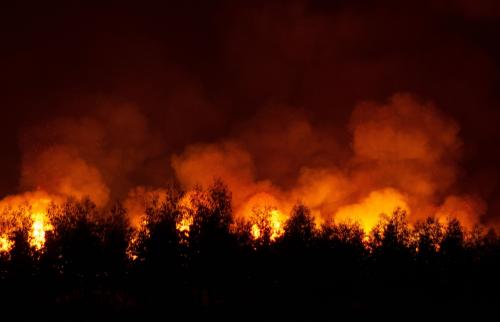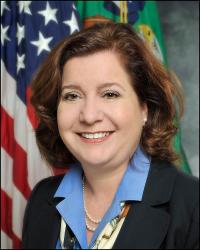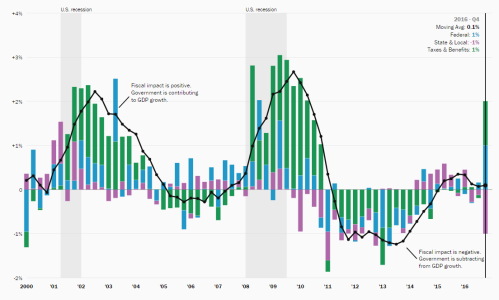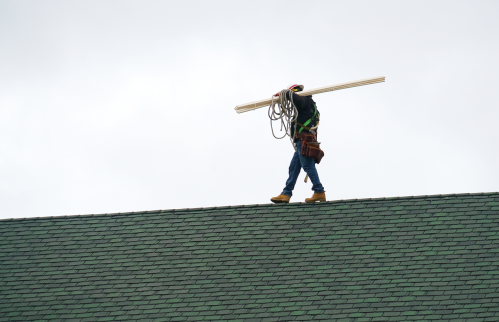Studies of the economic impacts of climate change often look at long-term, national costs. A new BPEA study takes a different approach, focusing on the current household level costs attributable to changing weather. The report authors examine a range of impacts, from mortality costs due of wildfire smoke to rising insurance costs along coastlines, to provide estimates of annual costs by region and socioeconomic status. On this episode of the Brookings Podcast on Economic Activity, two of the authors, Kimberly Clausing and Catherine Wolfram, join host Samantha Gross for a discussion of their findings and the implications for policymakers.
- Listen to the Brookings Podcast on Economic Activity on Apple, Spotify, YouTube, or wherever you like to get podcasts.
- Learn about other Brookings podcasts from the Brookings Podcast Network.
- Sign up for the podcasts newsletter for occasional updates on featured episodes and new shows.
- Send feedback email to [email protected].
Transcript
[music]
EBERLY: I am Jan Eberly, the James R. and Helen D. Russell Professor of Finance at Northwestern University.
STEINNSON: And I’m Jón Steinsson, Marek Professor of Public Policy and Economics at the University of California Berkeley.
EBERLY: We are the co-editors of the Brookings Papers on Economic Activity, a semi-annual academic conference and journal that pairs rigorous research with real-time policy analysis to address the most urgent economic challenges of the day.
STEINNSON: And this is the Brookings Podcast on Economic Activity, where we share conversations with leading economists on the research they do and how it will affect economic policy.
For decades, scientists have warned us about the risks of climate change, and studies have documented the national costs of increased climate disasters, both in lives and dollars. In a new study, “Who bears the burden of climate inaction?” Kimberly Clausing, Christopher Knittel, and Catherine Wolfram examine those costs at the household level with a special focus on which communities have been the most affected so far.
EBERLY: There are active debates about the future impact of climate change. The authors have current data on the impact that’s already happening. They focus on areas such as the cost of homeowners’ insurance and air conditioning that already hit households’ budgets, plus non-economic costs such as mortality due to poor air quality and excessive heat.
These examples point to different metrics for assessing climate impact, in particular weather extremes, not just the rising average temperature. These extremes have a disproportionate impact on poorer households and are likely to become larger over time.
STEINSSON: Today’s discussion will feature two of the paper’s co-authors, Kimberly Clausing, the Eric M. Zolt Chair in Tax Law and Policy at the UCLA School of Law, and Catherine Wolfram, William Barton Rogers Professor in Energy at the MIT Sloan School of Management. They will be joined by Samantha Gross, Director of Brookings’ Energy, Security, and Climate Initiative to discuss their findings.
GROSS: Thanks, Jan and Jón for that introduction, and welcome to Kim Clausing.
CLAUSING: Thanks so much for having me.
GROSS: And to Catherine Wolfram.
WOLFRAM: Great to be here, thanks.
GROSS: Oh, thank you! There are lots of studies examining the costs of climate change out there today, but you do something slightly different: you estimate the costs right now at the household level instead of some broad measure of future costs. How is this different from other studies, and how is it that nobody’s done this before?
[2:56]
WOLFRAM: Yeah, thanks. So, in the economics literature, a lot of the work has been done in the service of what’s known as the social cost of carbon. And that’s a technical term, but the basic exercise is to try to think about one ton of CO2 going into the atmosphere now, and then measure all the costs, all the economic costs associated with that ton. And since that ton is gonna stay in the atmosphere for a long, long time, the bulk of those costs are in the future.
So, a lot of the literature has been really focused on measuring cost over a very long time period, out into the 2100s. We thought that it was important to quantify the impacts that U.S. households are already experiencing, the impacts of climate change.
And your question about how has no one done this before? That’s kind of music to an academic’s ears, right? That suggests that you think it’s a good idea. So, we’re happy to fill that role and to do this exercise.
GROSS: Thanks, Catherine. So, what motivated you both to focus on the distributional aspects of climate change?
[4:08]
CLAUSING: Yeah, so Catherine and I actually first met at Treasury in the early Biden years, and one of the things that we asked ourselves is, why is it that people aren’t more interested in carbon pricing? And I think there was some reticence to embracing carbon pricing as a good climate policy option for the United States.
One big part of that reticence was the distributional effect. This concern that if you made energy more expensive, that it would disproportionately hurt those at the bottom of the distribution. And so, we started thinking about distribution more generally and if you think about climate policy, really a lot of it does have that possible characteristic, like if you regulate something, it also raises energy costs, and that could be regressive. If you give tax cuts to firms that might use clean energy, that might disproportionately help those at the top.
So, we saw this pattern over and over again, and there are ways you can address this. Chris Knittel, our third co-author, has some work talking about design solutions that would make carbon pricing more progressive, and people know that if you dividend it back to households, it’s more progressive. But what people don’t know is what happens if we do nothing?
Like, what are the distributional effects of that? And that’s something that we’re kind of investigating here. You know, we haven’t had really aggressive climate policy in the United States, but we have had the consequences of climate change, and if you look at those consequences, those two might be progressive and that has some important salience.
First, you know, it tells us that if we don’t do anything, that has a distributional impact. Two, so it kind of makes an argument for stronger policy, but second, I think it also helps us better understand public opinion in this area. So what we learn in our results is in part that some parts of the country and some people are experiencing climate change in a sort of big and salient way, but there’s a lot of other households that are seeing much smaller impacts, and that may not be transparently linking those impacts to what’s going on.
So, I think this can also help us unpack why climate action is so difficult.
GROSS: Yeah, I agree with you that we focus a lot on the costs of dealing with climate and absolutely not at all at the cost of not dealing with climate. So, I was excited to read this paper also.
So, what climate costs do you include in the study and how did you select the cost to include?
[6:36]
WOLFRAM: Sure. So, what we end up finding is that the big ticket items, meaning the things that are really impacting U.S. households a lot right now, are homeowners’ insurance as there are more and more storms, wildfires. Those are leading to more damage, and so people’s insurance costs, insurance premiums are going up.
We also look at households’ exposure to fine particulate matter from wildfire smoke and the cost that that has on, as we measure it, mortality, but something that’s outside of our study, but surely happening is that people are getting sick, even if they’re not dying. There’s been some literature that’s shown that after wildfire smoke, it’s not just the wildfire itself, but it’s, you know, you can be hundreds, even thousand miles away and you get exposed to the smoke. But people are finding that there are increased emergency room visits, so we find that that’s a big ticket item.
And then, the costs that state, local, and the federal government are bearing to clean up from the natural disasters and to help people out after the natural disasters. Those costs are being recovered through state, local, and federal taxes, and that we find is a big item.
So, we also looked at things that the previous literature has focused on, which are much more tied to kind of the direct impacts of temperatures, so that the previous literature is really focused on things like higher energy costs. As temperatures go up, households are spending more for air conditioning.
People have also looked at how as temperatures go up, there’s increased mortality, that heat can kill. And finally, that crop yields go down when there are lots of extreme heat days. So, we found that for U.S. households, that those costs were quite low. If you take the energy costs or the mortality costs, we find, and this is very consistent with a lot of previous literature that cold also kills and cold is also a driver of more energy costs.
And so the fact that it’s getting warmer, and it is certainly getting warmer, means their cost and benefits that people are less likely to die from cold, even if they are more likely to die from heat and they’re spending less on their heating bills, even if they are spending more on their air conditioning bills.
GROSS: So, Catherine, the effects that you’re talking about are all sort of second order effects of climate change: they’re not directly that the world got hotter, they’re the things that happened because the world got hotter, storms and fires and such.
But attribution is one of the biggest challenges of estimating the costs of climate change. To what extent is a natural disaster the result of climate change? And to what extent it is something that might have happened anyway? How do you handle that attribution challenge in your work?
[9:35]
WOLFRAM: Yeah, you’ve pinpointed an important challenge. So, one thing that we do is we take what we call a less conservative approach and a more conservative approach. So we try to bound things. The other thing we do is we look to the previous literature and see what climate scientists have assessed the increased rate of forest fires or the increased strength of hurricanes are, and I’m not a climate scientist, but I’ll try to summarize quickly what they do.
They basically build big atmospheric models and see what the model looks like with lower temperature, see what the model looks like with higher temperatures, and so they can assess how much more likely forest fires are and how much more likely storms and flooding is. So, we look to that literature.
I do think that that’s part of why economists at least haven’t focused on some of these, as you say, indirect impacts of climate change, ’cause it’s really handy to look at temperature. We have really good projections from climate scientists. Like very, very precisely how much temperature has changed already and how much temperature’s gonna change for the next couple hundred years.
But we think that it’s important to get comfortable with a little bit of uncertainty because certainly for U.S. households, we’re seeing that the direct impacts of temperature are kind of almost trivial relative to the indirect impacts the things like wildfire smoke and tire insurance costs.
GROSS: So, let’s get down to the actual answer to the question that you both are asking: what are the current costs to households of climate change and how do they vary across geography or across income levels? Like, who really is bearing the cost of climate change today?
[11:24]
CLAUSING: Yeah, so this really relates to Catherine’s prior answer. When you look at the costs, the vast majority of them are related to natural disasters. And so for the typical household, you know, it’s between $500-600 in our less conservative estimate. But there’s about 10% of households that have costs that exceed $900 a year, and most of those costs are either coming from the mortality associated with increased particulate matter from fires or other natural disasters, or from the increased home insurance costs, which are about $350 in the less conservative estimate.
So natural disasters are really driving a lot of the costs, and that has a big impact on where you see the cost, like which households are getting most hit. If you look at the map in our paper, you’ll see, well, rural California is one area that experiences high costs, and that’s explained by forest fires, which are driving up home insurance prices in rural California, but also causing more mortality in the counties where people are breathing a lot of that smoke.
Another region where you see really strong high costs is the Gulf Coast, right? And that the Gulf Coast has a lot of floods, hurricane damages, and the like, right? And that’s gonna drive a little bit of mortality, less than the particulate matter, but also higher insurance prices for houses.
And so, if you’re thinking about income distribution, then well, you also have to ask the questions, well, are those counties that are having these natural disasters, are they poorer or richer than typical counties? And on average, they’re poorer than typical counties, so you also get this pattern where both the mortality costs are declining as a share of income for counties and rich counties have less a particulate matter in their air than the poorer counties on average, right? Of course, there are exceptions, but also with respect to things like home insurance, it’s just a bigger share of a poorer person’s consumption bundle than it is of a richer person’s consumption bundle.
So, we get this sort of aggressive pattern across income, but also this geographically disparate pattern based on where the disasters are.
GROSS: Was there anything surprising in this data that jumped out at you, either geographically or at an income level on who’s most affected?
[13:41]
CLAUSING: The surprising thing was really what Catherine was pointing to earlier, which is: everybody has emphasized so much heat in this question, and you know, our first results to come back were actually saying, heating costs are falling in the winter, they’re rising in this summer because of cooling, so you’re getting a net, a very tiny effect from the change in temperature and on the mortality side too, right? You know, people are less likely to die of cold, more likely to die of heat, but it’s kind of netting out.
So, I think the surprising thing was how much of the total cost is really natural disaster driven and that does suggest, as Catherine points out, that this research is gonna be a little more difficult than if we could just use something really easy to measure like temperature. But that also is the finding that’s really driving the distributional patterns that I just mentioned.
GROSS: Yeah, I think that insight that economists have looked at temperature just because there was a thing they were more certain about is a really interesting one.
[14:36]
WOLFRAM: I would also add, I don’t think that people should get too fixated on the exact number that we come up with. We know that we are not measuring a number of things that are affecting U.S. households and we itemize those, but I do think, as Kim emphasized, the allocation between temperature-related expenses and natural disaster and wildfire-related expenses, we think is one of the key findings. I mean, we can tick off some of the things we know we’re missing. I already mentioned health costs in addition to mortality, but certainly there are other vectors that we’re not even able to measure. You know, if there’s a flood in Brazil and coffee prices go up, that’s something that U.S. households will bear.
So, I think, as I say, don’t get too fixated on the number, but we do think that the vectors are interesting.
GROSS: Yeah, the order of magnitude, I think, is the important part. And speaking of that, did your research give you any feel for how these costs might change over time or how the geographic or income distribution might change over time?
[15:40]
WOLFRAM: Yeah. I will say that in the research process, we actually got more and more current wildfire smoke data, and every time we added an additional year of data, things got worse. And so maybe that’s not a trend, maybe that’s just happenstance, maybe 2023 and 2024 were particularly bad years. I think we are gonna see year to year variation, but in general, the trend is gonna be in that direction with every year is gonna get worse.
I do think we should also pay attention to the potential for discontinuities, also. It might not just be that things trend upwards, but for instance, when reinsurance rates go up, there could be this real discontinuity in people’s insurance costs.
This is very much a study about what U.S. household’s current experiences, so asking us to project in the future is a little bit out of scope, but as you say, I think the research process itself unveiled some of what we might expect to see.
GROSS: So, getting to where the rubber meets the road on this, what can policy makers take away from your study? We know that climate policy is really tough right now, but on the other hand, everybody likes to see their expenses go down. Does that bring us some space to work to lower these costs, even in today’s difficult environment for climate policy?
[17:08]
CLAUSING: I think one of the interesting things here, building on the last question, is that we expect climate change to get worse over time, you know. All the climate modeling suggest that, but it’s also global collective action problems. We have to worry about how our actions influence other countries and how other countries influence us. So, this is a very difficult problem to solve.
But one of the interesting things about our results is it sort of implies that even if you take just a narrow view and you ask, what are the costs in the United States, period? You know, like pretend we don’t care about any other country in the world. They’re already really significant costs, and those costs compare, I think, favorably to the costs of climate action. In some work that Catherine and I did with John Bistline and Neil Mehrotra and Jim Stock, we found that the variation in household energy bills between a very aggressive climate policy and a very passive climate policy was really only about. 5%, no matter which policy lever you were moving.
And so that sort of implies that the cost that a household is gonna see is really already of a scale that might be dwarfed by the cost of inaction, right? So, if solving this problem or working to solve this problem together with other countries might cost your household $400, but you’re already suffering 500 from the climate change, that kind of makes for a more compelling policy case.
I also think there’s some things we could learn about policy design that could even insulate households from such modest costs, right? And, and we’re working on some work now about suggesting how we could make carbon pricing, for instance, more palatable in the United States by perhaps rebating some of the costs for households is one example, or just designing it with some carve-outs. But you could still get really effective climate policy from this tool. And a lot of other countries and subnational jurisdictions in the United States, including California, where I am today, are experiencing benefits in emissions reductions from carbon pricing at pretty low abatement costs, right? So, it’s a pretty efficient tool.
I also think there’s some really interesting policy implications based on the geographic element of this. And our third co-author, Chris Knittel, has done some really important work sort of thinking about how policy could adopt this geographic variation. You could imagine, for instance, that if certain states, take Montana as an example, are pretty rural and have high costs associated with energy, that you might be able to design the accompanying policy to make sure that Montanans aren’t more adversely affected than their urban counterparts.
And so I think that’s another way that our research meshes with prior research to suggest policy lessons here is there’s a way to kind of make for Pareto improving policy here, which for those who aren’t familiar with the term means you have a chance to make, in theory, everyone better off without making people worse off, if you’re careful with your policy design.
[20:04]
WOLFRAM: I would just chime in with two points, and one is a shout-out to one of our discussants, Wolfram Schlenker, who brought in some really interesting data showing how different the U.S. is in terms of exposure to flood costs and suggesting that in most other developed countries, they’ve taken many more steps to divert the water in ways that avoid having those costs happen in the first place. So, people talk about this as adaptation, but it does seem like an area where the U.S. could potentially learn a lot from other countries.
The second point I would make is, you said that it’s a challenging time for climate policy. That’s certainly the case in the U.S. I don’t wanna minimize that, but a lot of other countries are making progress and it is a global problem, right? The U.S. is only maybe 12% of global emissions, and so something Kim and I have been doing research on is an EU policy that is really pushing other countries to think hard about decarbonization and think hard about introducing carbon pricing.
So, the U.S. is a leader. The U.S. stepping back from that leadership position is a real loss, but there’s action that we’re seeing in other countries, and hopefully they can get together and make the sum greater than the parts.
GROSS: Thank you so much, Kim and Catherine, for your discussion. In my own work, I often emphasize that climate action can make everyone better off, and this focus on the costs and not the benefits is a real challenge. So, I was happy to read your paper, and it’s been a pleasure to talk to you both.
[21:45]
CLAUSING: Thanks so much for having us.
WOLFRAM: Yeah, thank you.
[music]
STEINNSON: Once again, I’m Jón Steinsson.
EBERLY: And I’m Jan Eberly.
STEINNSON: And this has been the Brookings Podcast on Economic Activity. Thanks to our guests for this great conversation and be sure to subscribe to get notifications about new releases of this podcast.
EBERLY: The Brookings Podcast on Economic Activity is produced by the Brookings Podcast Network. Learn more about this and our other podcasts at Brookings dot edu slash podcasts. Send feedback to podcasts at Brookings dot edu and find out more about the Brookings Papers on Economic Activity online at Brookings dot edu slash B-P-E-A.
STEINNSON: Thanks to the team that makes this podcast possible: Fred Dews, supervising producer, Chris Miller, co-producer, Gastón Reboredo, co-producer and audio engineer. Show art was designed by Katie Meris and promotional support comes from our colleagues in Brookings Communications.
The Brookings Institution is committed to quality, independence, and impact.
We are supported by a diverse array of funders. In line with our values and policies, each Brookings publication represents the sole views of its author(s).











Commentary
PodcastHow much is climate change costing US households?
Listen on
Brookings Podcast on Economic Activity
October 23, 2025